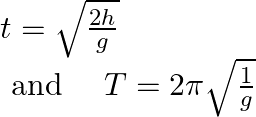Answer (1)
Sol. For surface of earth time taken in falling ![]() distance.
distance.

Given ![]()
![]()
For surface of other planet,
![]()
Time taken in falling h distance

Hence 
![]()
Answer (1)
Sol. For surface of earth time taken in falling ![]() distance.
distance.

Given ![]()
![]()
For surface of other planet,
![]()
Time taken in falling h distance

Hence 
![]()